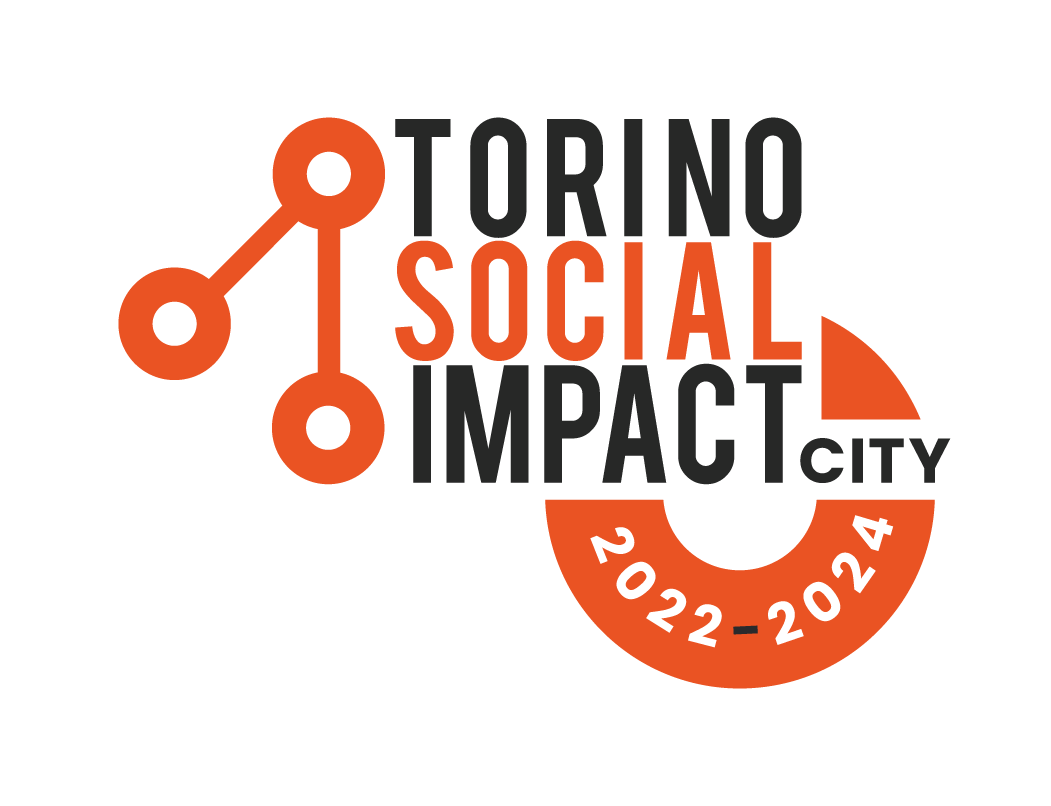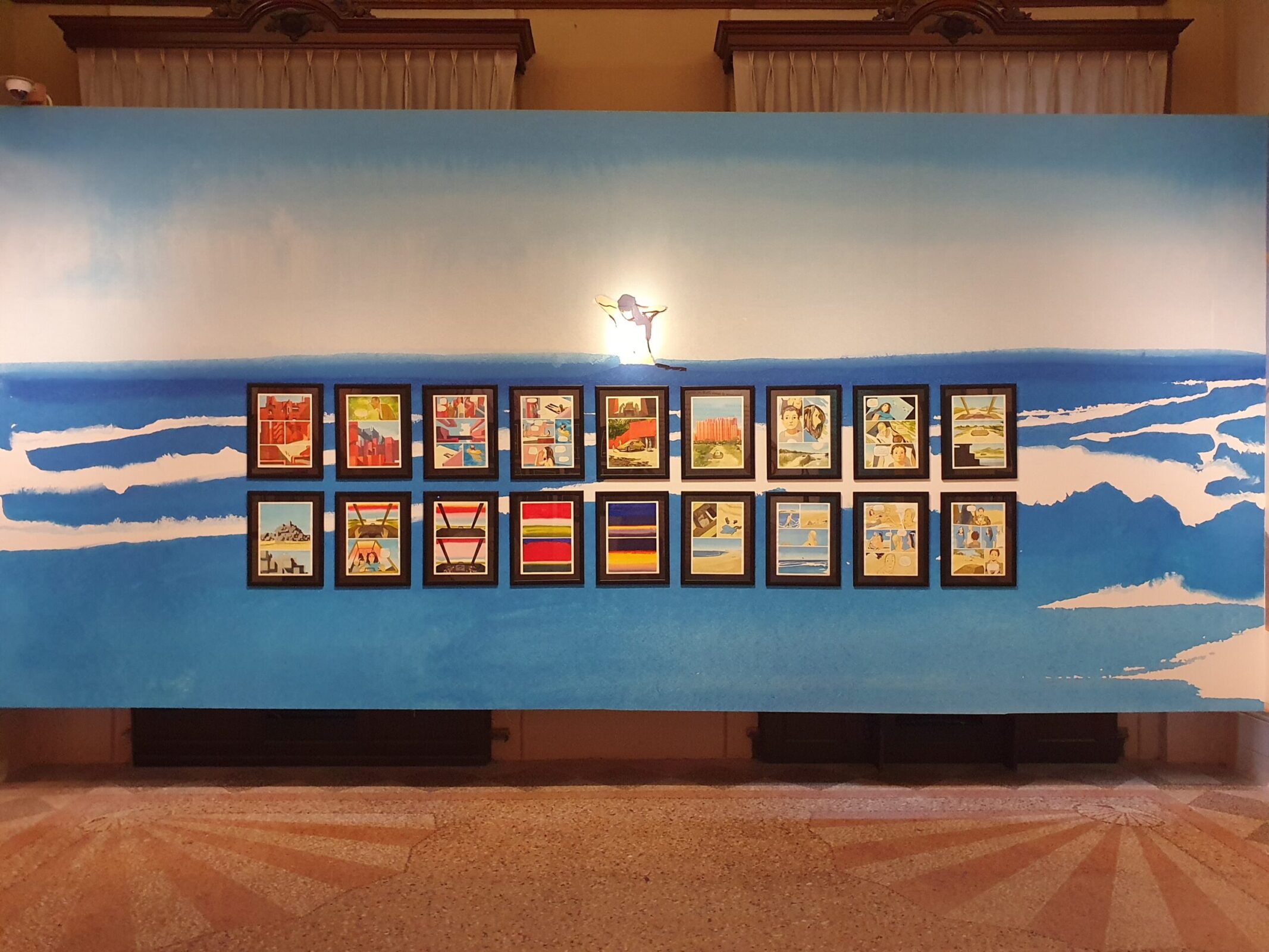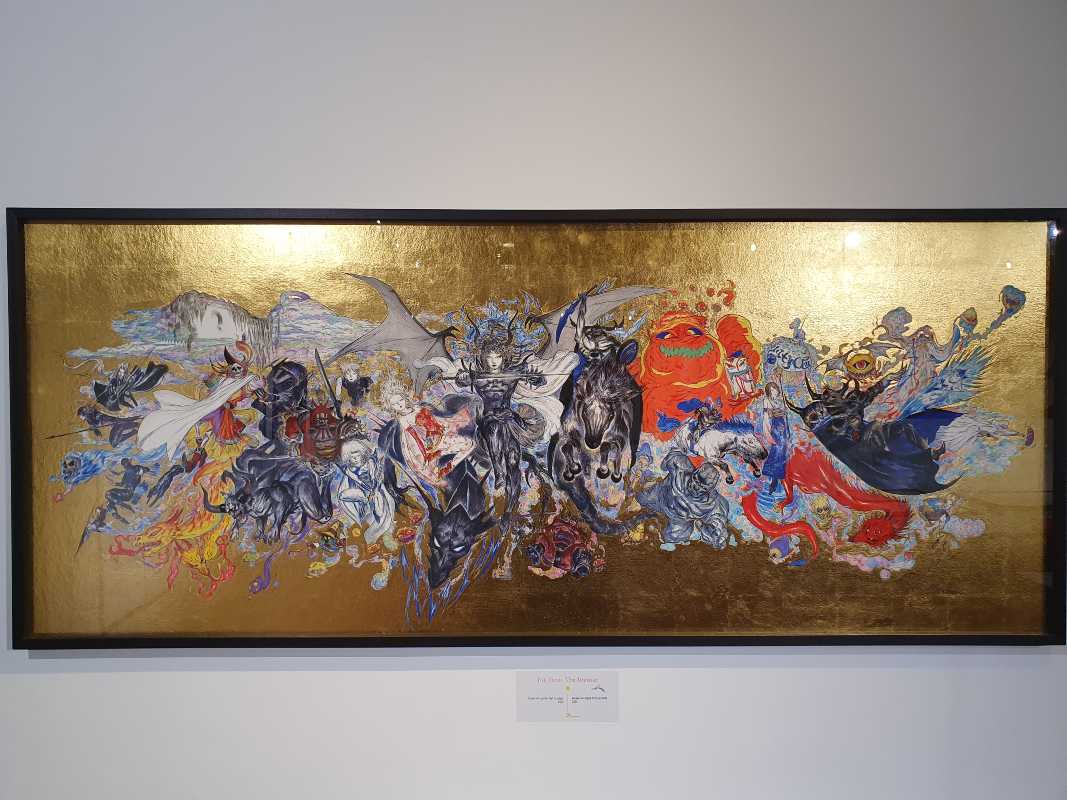
The gaze: that’s what probably comes to mind when one thinks of Yoshitaka Amano. It’s like his characters’ gaze stores a secret, be it melancholy or joyful, icy or warm. Although his work is impressive in many other ways, the gaze is like a magnet that quickly catches the viewer’s attention, and from there, the rest of the image spreads out. Visiting the exhibition Amano Corpus Animae is like walking through a gallery of gazes (the exhibition was first hosted in Milan, at the museum Fabbrica del Vapore, 13th Nov. 2024 – 1st Mar. 2025 and has now moved to Rome, at Palazzo Braschi, 28th Mar – 12 Oct. 2025). The look in the eyes of Amano’s characters evolved through the decades, as he enriched and personalized his style. Each gaze tells a different story, shedding a different light on the multiple worlds Amano imagined and painted.
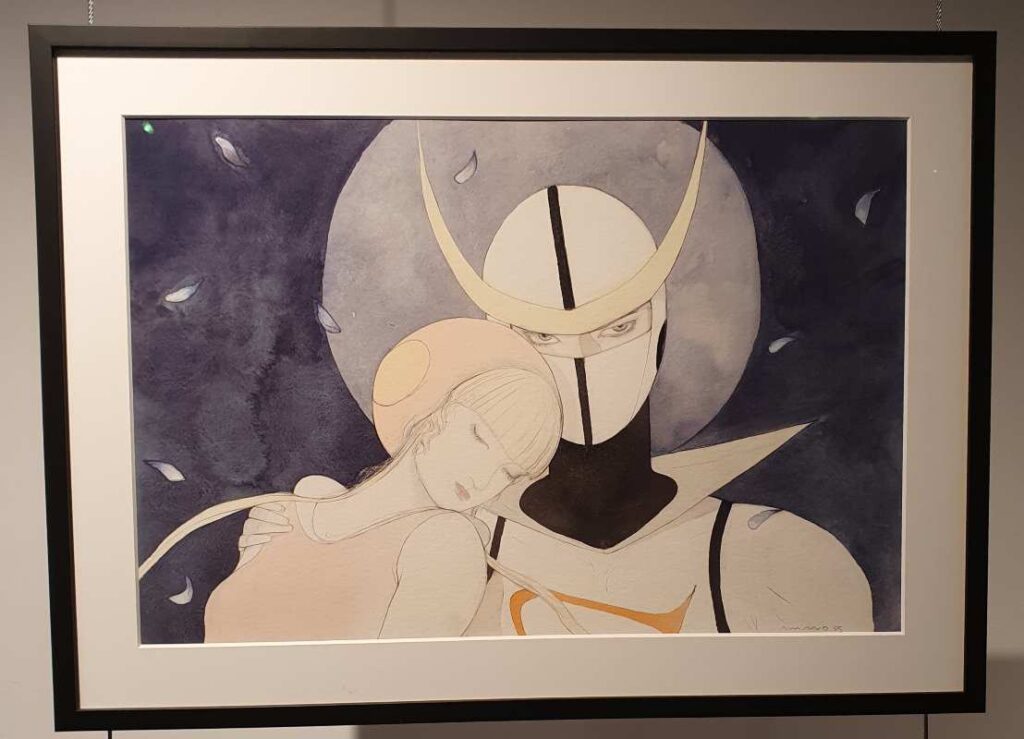
From his first experiences in the Japanese animation industry to his stardom as a freelance artist, Amano became an icon where different worlds meet: fine art, pop culture, tradition, innovation, animation, comics, video games, and fashion. Throughout the exhibition, the visitor can understand how he became a living intersection of all these art fields.
Amano’s first steps
Amano’s career begins with animation. He started to draw when he was just a child, and at the early age of fifteen, in 1967, he moved to Tokyo to work for the Tatsunoko animation studio. Soon appreciated for his style, after three years, the studio opened a new section dedicated exclusively to character designs. At first, Amano handled this part of the work independently, and one of his first successes was the adaptation of Pinocchio, which he made in 1972.
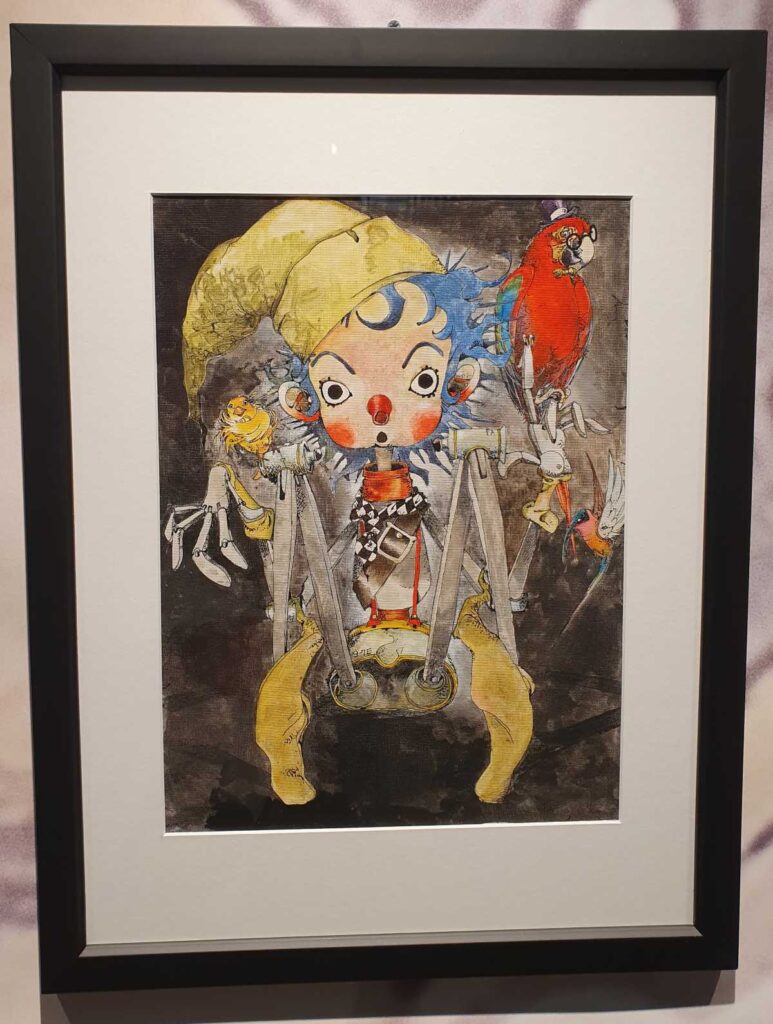
Amano worked at Tatsunoko for fifteen years, improving his art skills and working alongside soon-to-be big names of the industry: Mamoru Oshii (Ghost in the Shell), Masami Suda (Hokuto no Ken), and Takao Koyama (Dragon Ball). Although he designed the characters for animated series that made Tatsunoko popular, like Casshan or Tekkaman, Amano’s calling was to explore many other artistic contexts.
When your life becomes too stable, creativity dies
Yoshitaka Amano
While working for Tatsunoko, Amano studied Michelangelo and Raffaello, Gustav Klimt, Alphonse Mucha, Edgar Degas, Andy Warhol, and Neal Adams, his favorite American comics artist. He also studied Renaissance, Jugendstil, Art Noveau, Liberty, Ukiyo-e, and influences from the Heian period. Studying the masters of the past was essential in creating a unique style that welcomes elements from different times and places.
Following his artistic inclinations, he finally decided to leave Tatsunoko and start a career as a freelance artist in 1982.
The exploration of new worlds: Amano’s sci-fi and fantasy illustrations
Actually, his career as a freelancer started already in 1980, and in 1981, he launched an important collaboration with the S-F Magazine, which published authors like Isaac Asimov, Osamu Tezuka, and Leiji Matsumoto. During this period, Amano found the ideal ground to give life to his passion for sci-fi and fantasy. His style, so rich and full of details, could express itself freely and explore new horizons here.
However, a significant step in his career is his collaboration with Hideyuki Kikuchi, author of the Vampire Hunter D saga. From 1983 on, Amano illustrated more than forty volumes of novels and short story collections. Settled in a post-apocalyptic future where vampires rule, the story allowed the Japanese artist to illustrate a world with gothic and dark features. While depicting these characters and their world, Amano’s style became increasingly recognizable.
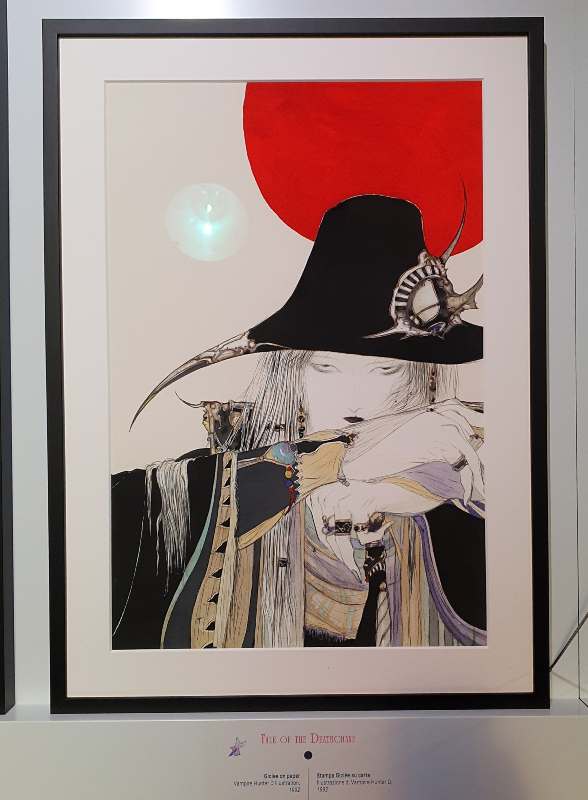
The protagonist D’s eerie gaze and the meticulous details of his armor and dress are two elements one will find in most of his subsequent work. Also, the recurrent presence of circles is typical, a symbol both of perfection and the infinite from Japanese culture and of the cyclic nature of life, as in Gustav Klimt’s paintings.
The growing appreciation for Amano’s work earned him the Seiun award as best Japanese artist four times between 1983 and 1986, along with collaborations with other popular sagas like Guin Saga and The Heroic Legend of Arslan.
This part of his career was also marked by an essential collaboration with Mamoru Oshii for an animated movie, Angel’s Egg. With a mix of sci-fi, fantasy, and religious features, Amano and Oshii created something that surprised critics and audiences. With few and brief dialogues, the movie mainly relies on images and music, enacting a hermetic storytelling with no precedent in the animation field.
A forty-years long collaboration: the Final Fantasy saga
As a further sign of his increasing popularity, the first art book by Amano, Maten, came out. It was 1984. However, his encounter with the world of video games threw him into international stardom. Despite other significant collaborations (Fron Mission, El Dorado), Amano’s name is tightly bonded to the Final Fantasy saga. Back in 1986, the director and father of the project, Hironobu Sakaguchi, wanted to create something astonishing, able to compete with the first chapter of another popular saga, Dragon Quest. It was a stiff challenge since the videogame got the character designs and the artistic supervision of Akira Toriyama, extremely popular thanks to Dr. Slump and Dragon Ball.
Sakaguchi thought of Jean “Moebius” Giraud and Yoshitaka Amano to get an equally strong artistic view for his project. The choice then fell onto the latter, and Amano’s name is still bonded to Final Fantasy after sixteen chapters and several other video games. With Nobuo Uematsu’s soundtracks, Amano’s art contributed to creating Final Fantasy‘s complex and rich imaginary worlds. From the game’s logo on the boxes to the characters’ design, Amano created real icons, like the Warrior of Light from Final Fantasy (1987), Cecil from Final Fantasy IV (1991) or Kefka from Final Fantasy VI (1994), one of the most appreciated villains of the saga.
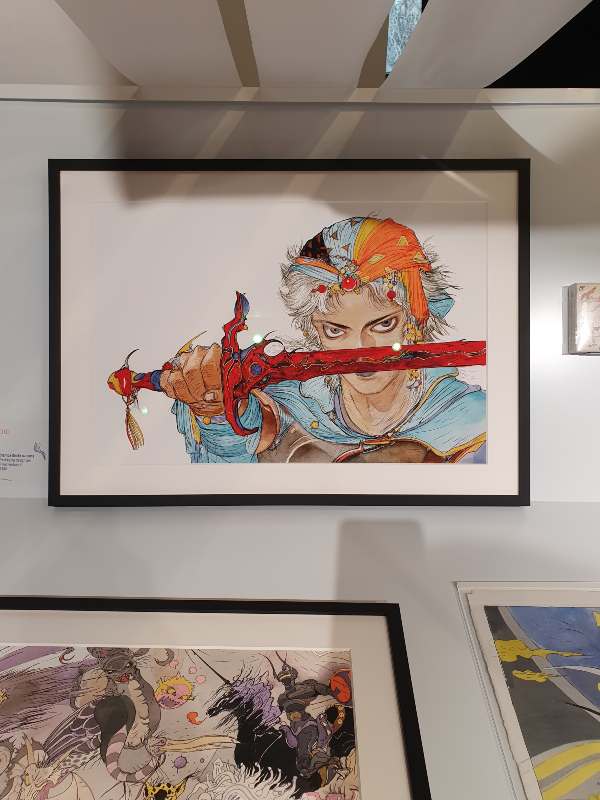
Especially in the first chapters, the contrast between the illustrations and the actual game was quite stark due to the limited possibilities of the video games of the 1980s-90s. However, Amano’s mesmerizing and detailed drawings helped the gamers imagine all the elements the video games of the time couldn’t deliver properly, becoming a significant part of the gaming experience.
Starting in the sixth chapter, Amano reduced his artistic involvement in the saga, focusing more and more on the promotional materials and the cover logo, leaving Tetsuya Nomura (Kingdom Hearts) to design the characters.
Landing in New York City
New York is my fantasy city, a place where I can dream freely and without constrictions of the known
Yoshitaka Amano
Moving to New York and joining its circle of exhibitions and galleries established Amano’s relevance as an international artist. He also got the chance to get closer to the contemporary art scene and expand his constant dialogue between tradition and innovation. Experiences and new perspectives were gathered in his first exhibition in New York in 1997, Think Like Amano.
In 1998, he illustrated a celebrative cover for the comics series The Sandman. Neil Gaiman was impressed by Amano’s work, and the two started a collaboration the next year. Recently, it has become increasingly troubling to mention Gaiman’s works and name due to the assault allegations against him. However, following Amano’s career, one cannot overlook Dream Hunters (1999), a stand-alone story Gaiman wrote purposefully to be illustrated by the Japanese artist.
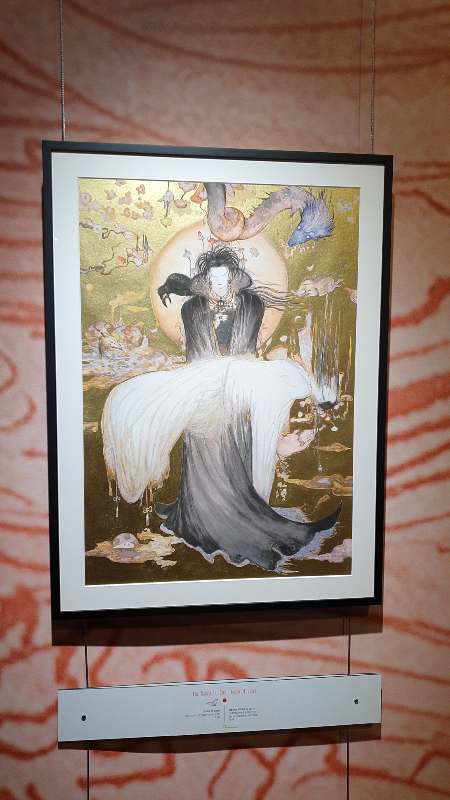
It was the encounter of two huge imaginative worlds. On the one hand, The Sandman, the “story about stories” that, with its protagonist Morpheus and his family, the Eternals, charmed thousands of readers worldwide. On the other hand, Amano’s vision, where Japanese and Western art meet to travel through sci-fi landscapes, fantasy, and, in this case, dreams. Despite the first commission of circa twenty illustrations, Amano was so involved in the story that he made roughly eighty. The enigmatic and contemplative style of the drawings intertwined with the philosophical and minimal quality of the writings. While giving life to a story strongly inspired by Japanese folklore, Amano took inspiration from Japanese fine art, outlining the characters and staging the scenes. However, the use of colors and his style are also evident influences from European artists like Mucha and Klimt.
Amano Corpus Animae: how art and pop-culture mingle
In New York, Amano also had the chance to assimilate the lesson of an artist he honestly admired, Andy Warhol. Following the ideas of the father of pop-art, Amano’s work is a constant monument to the contamination between fine arts and mainstream culture.
Visiting Amano’s exhibition, one can pass from the huge panels April and May hanging from the ceiling to the Final Fantasy boxes on display without feeling that some works are more prestigious than others. On the contrary, Amano’s strength is showing that video game packaging can be as artistic as a painting or a statue in a museum.
Independently from the medium where it’s displayed, Amano’s art will reach and impress the viewers, disregarding any distinction between high and low culture. Allergic to the idea of forcing any kind of limit on his work, Amano kept on exploring different fields while maintaining the main traits of his style: the penetrating gaze, the thin and elegant lines, and the abundant use of red, blue, gold, and black.
Amano meets the superheroes
His style remains highly personal even in a distant field, like superhero comics. Thanks to the international success of Dream Hunters, Amano started further collaborations in the comics field. An interesting part of his work, where with several celebrative covers for DC Comics, he manages to reinterpret icons like Batman and Superman, conveying their essence but from an utterly unusual perspective. To make an example, in a variant cover of the 2022 for Detective Comics 1063, Amano represents the gothic and dark aspects of Batman but distances from the American representations: his delicate trait and the touches of blue and gray of the female subject and the background give an eerie and dreamy feeling to the painting.
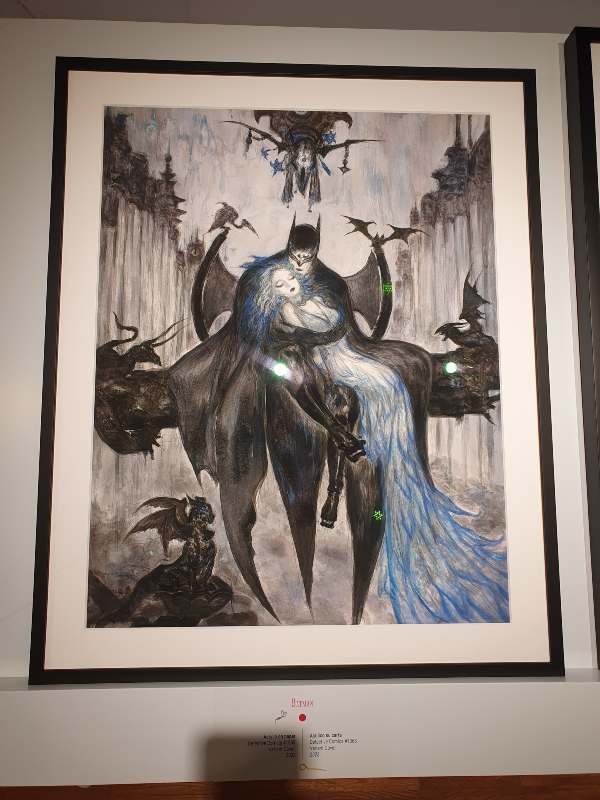
Superhero comics have also been an occasion to employ his inclination to portray female characters. In 2001, he illustrated a story by Greg Rucka, published by Marvel, with Elektra and Wolverine as protagonists, Elektra & Wolverine: The Redeemer.
Magic, Vogue, and much more: a free spirit showcased at Amano Corpus Animae
Amano’s open-minded approach brought him to collaborate with another dynamic artistic field like card game illustration: in 2019, he realized an illustration for a card of Magic: The Gathering, Liliana, Dreadhorde General, a significative summary of his work in terms of image composition, traits and colors. However, regarding exploring the unknown, Amano’s participation in Vogue Italia’s issue of January 2020 is one of his most relevant works. For the first time, the fashion magazine wanted to portray the dresses without taking pictures of the models wearing them. The magazine used illustrations of renowned artists worldwide, such as Milo Manara and Yoshitaka Amano. Always passionate about fashion, he contributed nine paintings, and the illustration of dresses became another expression of his art.
Amano’s devoted search for something new is also evident in the Candy Girl series or in the giant panels of Deva Loka and Spring Awakening. In both cases, there’s an unusual employment of flatter and more vivid colors. The Candy Girls catch the eye for their playful style and precise traits, with most close-ups of the subjects’ faces and primarily simple and minimal image composition. On the contrary, in Deva Loka and Spring Awakening, it’s like Amano unleashed his imagination, letting it create with any restraint: two paintings with a lysergic effect, that however, both find their center and a sense of quiet in the slender and white-colored female figures. A style that somehow recalls the short musical movie 1001 Nights realized by Amano in 1998 with the music by the Los Angeles Philharmonic Orchestra.
Amano Corpus Animae: the biggest so far in a Western country
Made in collaboration with Lucca Comics & Games, with more than 130 illustrations, Amano Corpus Animae is the biggest Amano exhibition in a Western country. Ideally, the itinerary ends with the three panels the artist made for Lucca Comics & Games 2024: a celebration of the centenary of Giacomo Puccini’s death, a personal interpretation of Tosca, Madama Butterfly, and Turandot. Yet another example of how much Amano, after a more than fifty years-long career, still travels nimbly between different worlds, always bringing his view that keeps on impressing viewers, crossing gaze with his enigmatic characters.
I’ve seen a lot of artists trapped in their style, and I still fear that trap.
Yoshitaka Amano

